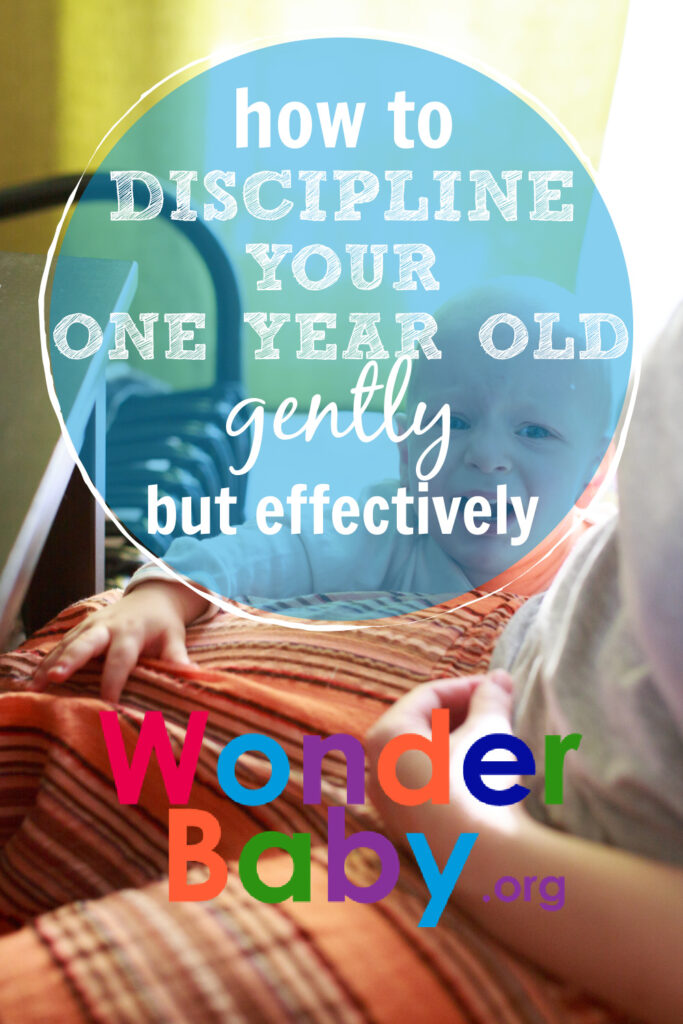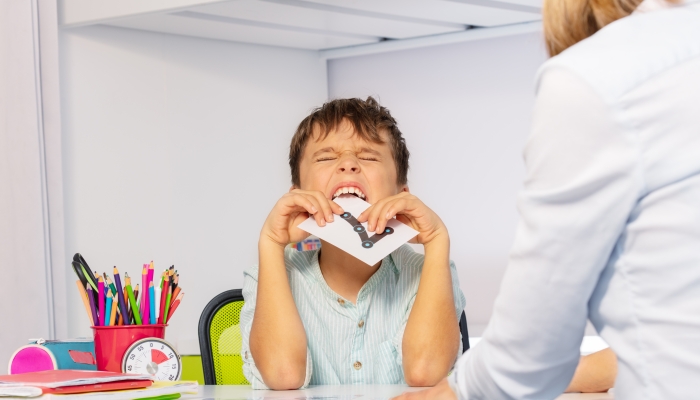How to Discipline a One Year Old Gently but Effectively

This post may contain affiliate links; please see our terms of use for details.
- Use positive reinforcement for accepted behaviors.
- Use a system of “fines” to remove a toy or privilege as punishment.
- Redirect their attention to accepted behaviors.
- Use assertive tones of voice to help your child understand.
Many parents struggle to determine the best way to discipline their babies and toddlers. If you’ve ever wondered how to discipline a one year old gently but effectively, there are a range of practical tips you can use. Redirection techniques, assertive tone of voice, consistent disciplining, and proactive discipline methods are all helpful and effective.
Whether your child is just being overly curious or has a habit of throwing a temper tantrum to get their way, gentle and effective discipline can start from a very young age and will develop over time as your child grows. With clear boundaries and positive discipline techniques, even very young children can learn to understand right from wrong.
Can a One Year Old Understand Discipline?
Discipline can be a difficult concept for a one-year-old toddler to understand. However, at this age they can still learn certain boundaries. Most of your disciplining at this age will be setting limits and teaching your child what good behavior is, instead of explicitly disciplining them for unwanted behavior.
At What Age Do Babies Know Right From Wrong?
Understanding the difference between right and wrong is a complex cognitive skill, developed in the prefrontal cortex part of the brain, which children won’t fully grasp for many years. Studies have shown that the prefrontal cortex continues to grow well into a person’s adult maturity.
However, since this part of the brain starts to develop before birth, it’s not impossible to help your toddler understand good behavior and bad behavior. It will require persistence and patience, but even a one or two year old can understand simple limitations.

How To Discipline a One Year Old
If the time comes that your energetic toddler needs to be disciplined, many parents will opt for time-outs. While this is an effective way to discipline some young children, others may require alternative methods such as redirection, an assertive voice, or the removal of a toy or privilege.
How To Discipline a One Year Old Who Throws Tantrums
Toddlers who throw temper tantrums can quickly wear down your patience. However, remaining calm when deciding on disciplinary action is vital. Dealing with a one year old’s behavior problems can be daunting and frustrating, especially for new parents, so it’s common to feel overwhelmed at times. Stay calm. Deep breaths can help!
Children learn how to self-regulate their temper by watching you. If you can’t remain calm or control your temper when you feel frustrated, you can’t expect your toddler to either. Give them a solid role model that is contemplative and calm, and they will develop the same skills.
Use Positive Reinforcement
Instead of disciplining a behavior you don’t want, try to use positive discipline techniques with behaviors you do want. If you try to verbalize why you don’t allow particular behavior, your child may struggle to understand what you are trying to say.
For example, instead of disciplining a child who throws bedtime tantrums, use positive reinforcement when they get into bed by reading them a favorite story or letting them snuggle with a favorite bedtime toy. A little bit of positive parenting goes a long way!
How To Discipline a One Year Old Who Hits or Bites
When a toddler is angry, they may resort to hitting, kicking, or throwing food in an attempt to vent their frustration as well as get their way. This is a behavior you should put a stop to quickly.
Issuing a Fine
One way to address this is by issuing the toddler a “fine.” For example, if your toddler has hit you or other children with a toy, take away the toy as a fine for this bad behavior. Explain that there is to be “no hitting” and that there will be “no toy when you hit.”
This type of discipline is an excellent alternative to a time-out and can quickly stop the behavior while also giving your child a chance to think about the pros and cons of their actions.
Redirecting Their Attention
If a child is angry and simply throwing a temper tantrum with hitting, kicking, or biting, try redirecting their attention to something else. Sometimes anger can be the result of boredom. Shift your toddler’s attention to something positive, such as a new toy, a storybook, blowing bubbles, or letting them look through a window to the outdoors. By focusing on something else, you can stop bad behavior and reward good behavior.

How To Discipline a One Year Old Who Doesn’t Listen
Trying to discipline when your strong-willed toddler doesn’t listen to “no” can be a lesson in parenting patience. Whether your child is just being stubborn or has some learning difficulties that prevent them from focusing on your words, getting a toddler to take you seriously can be difficult.
Use Assertive Vocal Tones
Babies and toddlers may not fully understand the words you are telling them when it comes to explaining why they’re being disciplined, but a change in your tone of voice can be understood much easier.
Speak in an assertive and deep tone and let your toddler understand that their behavior is unacceptable and should not be repeated. You can also use the word “no” or the phrase “stop doing that” to give them an additional verbal cue that their bad behavior is unacceptable.
Be Consistent
Consistency is key, especially when dealing with children who try to tune you out. Learning right from wrong will be much easier for your toddler if you remain consistent in what is off-limits, what is acceptable, and how you deal with it. If you praise or condemn a behavior one day, don’t ignore it the next day. This will become confusing. Treat it the same way you did before and ensure all caregivers are on the same page.
On the other hand, if something is off-limits, keep it off-limits. Don’t be firm in discipline one day, then slack off on it the next. Since your toddler is still learning the difference between right and wrong, staying consistent can help them remember what is and is not proper behavior and how to follow rules.
How NOT to Discipline a One Year Old
Now that you know how to discipline a toddler in a variety of ways, let’s go over ways you should never discipline a toddler. Every parent knows a child can and will test your patience and will, at times, make you angry. Physical punishment should never be considered an acceptable form of discipline at any age.
Hitting, slapping, or spanking can all lead to your toddler thinking that this form of behavior is acceptable when venting frustration. As a result, you could soon have an out-of-control toddler on your hands that throws tantrums, kicks, hits, bites, and more when they are angry and venting their frustrations. Over time, this bad behavior can lead to extreme toddler aggression.
If you find yourself becoming overly angry when disciplining your child, try venting your anger by clapping your hands or squeezing a stress-relieving toy. Hitting, slapping, or spanking your toddler will not lead to anything beneficial for either of you, and you should make an effort to understand how to discipline a one year old without yelling as well.
Things Not to Discipline Your Toddler For
Toddlers are curious, and once they start becoming more mobile and active, they will be getting into everything. While the best option to prevent mishaps is to childproof your home, it’s also important to accept that your toddler will be exploring and inspecting pretty much everything as they grow and learn.
Let your child learn independently, within reason, and within set limits. Let them touch and inspect things freely until their curiosity is satisfied. Don’t discipline your toddler just for exploring their home or developing their motor skills and senses by touching certain items.

Proactive Discipline with Baby Proofing
Instead of constantly telling your toddler “no,” use babyproofing to create a safe environment where your toddler can explore freely. Instead of always trying to pay attention to your toddler’s every move, use child locks, baby gates, and other means to help keep them safe and protected from hazards around the home.
For example, instead of limiting your child’s access to the stairs by constantly telling them “no” when they get close, install a secure baby gate so your child can still have their freedom while still being protected from a tumble down the stairs.
Protective coverings to secure cords out of reach, outlet plug covers, oven and doorknob protectors, and anti-tipping furniture safety straps are all ways you can make your home safer so your toddler has a chance to inspect their home at their own pace.
Proactive discipline strategies can go a long way toward giving your child the freedom they need to learn and develop naturally while limiting the amount of potential conflict and reactive discipline you need to engage in.

Related Posts

Behavior
Understanding Intermittent Explosive Disorder in Children
Are you worried about your child’s unexpected aggression and explosive behaviors? Learn how to support a child with intermittent explosive disorder.

Behavior
5 Emotional Regulation Activities for Kids
Want to teach your child how to regulate emotions? Here are emotional regulation activities for kids that can help!

Behavior, Special Needs
5 Tips for Dining Out with Children Who Have Sensory Sensitivities
Worried about dining out with sensory sensitivities? Try these tips for less stress and more fun the next time you take your family out to eat.